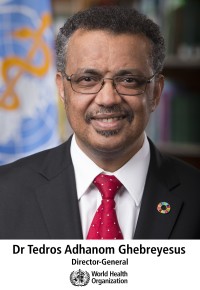
[the_ad_placement id=”adsense-in-feed”]
– globalbihari bureau
 Geneva: Almost 80% of the 2,30,000 cases of COVID-19 that were reported to World Health Organisation (WHO) on Sunday were from just 10 countries, and 50% come from just two countries, the WHO Director-General, Dr. Tedros Adhanom Ghebreyesus told mediapersons here on Monday.
Geneva: Almost 80% of the 2,30,000 cases of COVID-19 that were reported to World Health Organisation (WHO) on Sunday were from just 10 countries, and 50% come from just two countries, the WHO Director-General, Dr. Tedros Adhanom Ghebreyesus told mediapersons here on Monday.
“All countries are at risk of the virus, as you know, but not all countries have been affected in the same way,” he said. He pointed out that the Americas, South Asia, and several countries in Africa were now seeing intense transmission phase of their outbreak. He said the epicentre of the virus remained in the Americas, where more than 50% of the world’s cases had been recorded.
[the_ad_placement id=”content-placement-after-3rd-paragraph”]
Dr. Ghebreyesus informed that the number of daily deaths “remains relatively stable”, but said there was “a lot to be concerned about”. He added: “Let me blunt, too many countries are headed in the wrong direction.The virus remains public enemy number one, but the actions of many governments and people do not reflect this.”
The Director-General said while the only aim of the virus was to find people to infect, mixed messages from leaders were undermining the most critical ingredient of any response: trust.
“If governments do not clearly communicate with their citizens and roll out a comprehensive strategy focused on suppressing transmission and saving lives; If populations do not follow the basic public health principles of physical distancing, hand washing, wearing masks, coughing etiquette and staying at home when sick; If the basics aren’t followed, there is only one way this pandemic is going to go. It’s going to get worse and worse and worse. But it does not have to be this way,” he warned.
Dr. Ghebreyesus said every single leader, every single government and every single person could do their bit to break chains of transmission and end the collective suffering. “I am not saying it’s easy; it’s clearly not. I know that many leaders are working in difficult circumstances,” he said.
He warned that there were no shortcuts out of this pandemic. “We all hope there will be an effective vaccine, but we need to focus on using the tools we have now to suppress transmission and save lives. We need to reach a sustainable situation where we have adequate control of this virus without shutting down our lives entirely, or lurching from lockdown to lockdown; which has a hugely detrimental impact on societies,” he said.
“I want to be straight with you: there will be no return to the “old normal” for the foreseeable future. But there is a roadmap to a situation where we can control the disease and get on with our lives,” he said and added that this was going to require three things:
- A focus on reducing mortality and suppressing transmission
- An empowered, engaged community that takes individual behaviour measures in the interest of each other
- Strong government leadership and coordination of comprehensive strategies that were communicated clearly and consistently.
According to Dr. Ghebreyesus, there were roughly four situations playing out across the world at the moment. They were:
- The first situation was countries that were alert and aware – they prepared and responded rapidly and effectively to the first cases. As a result, they have so far avoided large outbreaks. He cited the examples of several countries in the Mekong region, the Pacific, the Caribbean and Africa that fitted into that category. Here, he said, leaders of those countries took command of the emergency and communicated effectively with their populations about the measures that had to be taken. They pursued a comprehensive strategy to find, isolate, test and care for cases, and to trace and quarantine contacts, and were able to suppress the virus.
- The second situation was countries in which there was a major outbreak that was brought under control through a combination of strong leadership and populations adhering to key public health measures. He said many countries in Europe and elsewhere had demonstrated that it was possible to bring large outbreaks under control. “In both of these first two situations, where countries have effectively suppressed the virus, leaders are opening up their societies on a data-driven, step-by-step basis, with a comprehensive public health approach, backed by a strong health workforce and community buy-in,” he said.
- The third situation was countries that overcame the first peak of the outbreak, but having eased restrictions, were now struggling with new peaks and accelerating cases. “In several countries across the world, we are now seeing dangerous increases in cases, and hospital wards filling up again. It would appear that many countries are losing gains made as proven measures to reduce risk are not implemented or followed,” he said.
- The fourth situation was those countries that are in the intense transmission phase of their outbreak. “We’re seeing this across the Americas, South Asia, and several countries in Africa.
He said that the first two situations indicated that that it was never too late to bring the virus under control, even if there had been explosive transmission. “In some cities and regions where transmission is intense, severe restrictions have been reinstated to bring the outbreak under control,” he said, reiterating the WHO’s commitment towards working with all countries and all people to suppress transmission, reduce mortality, support communities to protect themselves and others, and support strong government leadership and coordination.
“It can be done. It must be done. I have said it before and I will keep saying it. No matter where a country is in its epidemic curve, it is never too late to take decisive action. Implement the basics and work with community leaders and all stakeholders to deliver clear public health messages. We weren’t prepared collectively, but we must use all the tools we have to bring this pandemic under control. And we need to do it right now. Together, we must accelerate the science as quickly as possible, find joint solutions to COVID-19 and through solidarity build a cohesive global response. Science, solutions and solidarity, he said.
He asserted that while it was too soon to assess the full impact of COVID-19, 130 million more people may face chronic hunger by the end of this year.
[the_ad_placement id=”sidebar-feed”]





